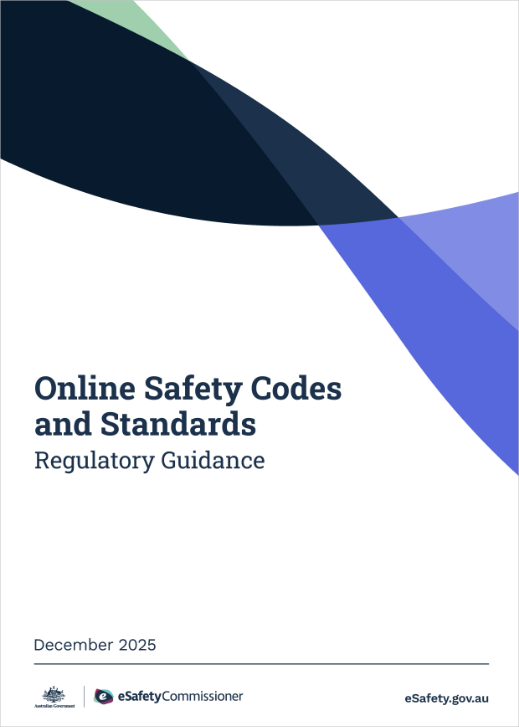Online Safety Codes and Standards
Online Safety Codes and Standards are designed to protect Australians from illegal and restricted online content.
On this page:
Stay up to date
Sign up for online safety news and guidance for industry, to help you meet your obligations and support safer online experiences.
Industry codes and standards at a glance
The Online Safety Codes and Standards (previously known as ‘Industry Codes and Standards’) were developed in two phases.
Unlawful Material Codes and Standards
The Unlawful Material Codes and Standards were developed as part of the first phase. There are six codes and two standards in operation that contain measures to address ‘class 1A’ and ‘class 1B’ online material. These classes cover the most seriously harmful online content, such as child sexual exploitation material and pro-terror material.
These six codes apply to social media services, app distribution services, hosting services, internet carriage services, equipment providers, and search engine services. The two standards apply to relevant electronic services and designated internet services.
Service providers can find more information on how to communicate with eSafety and report on compliance measures in the Unlawful Material Codes and Standards. There is also a page with frequently asked questions about applying the correct code or standard.
Age-Restricted Material Codes
The Age-Restricted Material Codes were developed as part of the second phase. There are nine codes, focusing on ‘class 1C’ and ‘class 2’ material, such as online pornography that is inappropriate for children.
Three codes were registered on 27 June 2025 and come into effect on 27 December 2025. These apply to hosting services, internet carriage services and search engine services.
The remaining six codes were registered on 9 September 2025 and come into effect on various dates starting from 9 March 2026. These apply to app distribution platforms, equipment providers, social media services (core features), social media services (messaging features), relevant electronic services and designated internet services. Find more information about how the codes impact the access to online porn and other adult content.
You can make a complaint to eSafety if you believe an online service is not complying with an Online Safety Code or Standard that is in effect.
eSafety is required to maintain a register of online industry codes and industry standards. The register contains the industry codes and standards, as well as the notices issued to representatives of online industry sections.
Understanding the Online Safety Codes and Standards
The Online Safety Codes and Standards Regulatory Guidance is designed to help online service providers comply with the requirements for each code and standard.
It provides information on key matters including code compliance reporting, communicating with eSafety, and how the Online Safety Codes and Standards interact with eSafety’s other regulatory schemes.
eSafety encourages providers to review the regulatory guidance for Online Safety Codes and Standards along with eSafety’s Safety by Design principles and assessment tools. These resources enable service providers to audit and improve their current safety practices and help position themselves to comply with the obligations under the Online Safety Codes and Standards.
More information
Find more information about the Online Safety Codes and Standards
- Read more about the background and development of the Unlawful Material Codes, including information about the consultation process.
- Read more about the background and development of the Unlawful Material Standards, including information about the public consultation process. Supplementary explanatory statements for each standard can be found on the register maintained by eSafety.
- Read more about the background and development of the Age-Restricted Material Codes, including information about the consultation process.
- Check frequently asked questions about applying the correct Unlawful Material Standard or Code.
- Check frequently asked questions about the Age-Restricted Material Codes for users.
- Check frequently asked questions about the Age-Restricted Material Codes for regulated entities.
The Voluntary Online Dating Code
Some online dating services have signed up to a new voluntary industry code to improve safety on these services for Australians. eSafety has no role in enforcing the code and has no legislative powers relating to its operation. Enforcement and oversight of the Voluntary Online Dating Code is the responsibility of an independent, industry-formed Code Compliance Committee.
At the request of the Minister for Communications, eSafety will commence an assessment of the efficacy of the Voluntary Online Dating Code after mandatory code compliance reports are received in the second half of 2025. If the code has not been effective in reducing harms to Australians, Government will consider whether further action is needed, including regulation.
Last updated: 04/12/2025
